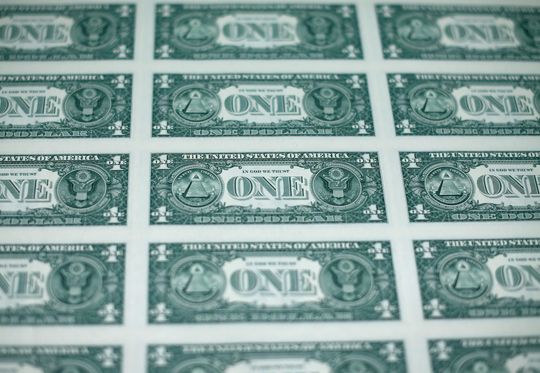Investors pricing in scenario that is ‘stuff of fairy tales,’ strategist warns
The U.S. dollar is offering up an early 2022 head scratcher: Why does the currency keep falling even as traders aggressively pencil in as many as four interest rate increases by the Federal Reserve this year as it scrambles to rein in red-hot inflation?
The ICE U.S. Dollar Index DXY, -0.06%, a measure of the currency against a basket of six major rivals, was down 0.1% on Thursday at 94.81, hitting a two-month low. The index is off 1% so far this week, leaving it with a loss of 1.2% since the start of the new year.
A more aggressive tightening of monetary policy, from a more “hawkish” central bank, would usually be expected to support a currency. The reaction may make more sense, however, if one looks at how little interest rates are expected to ultimately rise once the Fed begins the rate-hike cycle, said Kit Juckes, global macro strategist at Société Générale.
He noted that while traders have moved quickly to price in four rate increases this year, they still look for the fed-funds rate, currently in a range of 0% to 0.25%, to top out at no higher than 2%. That’s not realistic, but it may explain the recent performance not only of the dollar, but other assets as well.
“Markets are in wonderland,” he said, in a Thursday note.
U.S. stock-market investors are cheered by the prospect of a “terminal rate” of 2%, and ignoring a more hawkish Fed because the prospect of faster rate hikes reflects hopes the worst of the COVID-19 pandemic is over, he said.
A fed-funds rate topping out at 2% is a “Goldilocks” scenario — to the extreme, Juckes said, and it’s reflected in a reaction Wednesday to a 7% year-over-year rise in the December consumer-price index, a nearly 40-year high, that saw the S&P 500 SPX, -1.42% climb back within 2% of its all-time high and the Cboe Volatility Index VIX, +15.27% fall back hard.
Need to Know: Is it time to fight the Fed? This veteran strategist says the central bank won’t risk a 20% drop in house prices and a 30% slide in stocks.
The VIX, a measure of expected S&P 500 volatility, spiked to a more-than-four-week high above 23 earlier this week before sliding back below its long-term average around 19. Stocks lost ground Thursday as a bounce by tech stocks lost steam, leaving the Nasdaq Composite COMP, -2.51% down 2.5%, while the S&P 500 lost 1.4% and the Dow Jones Industrial Average DJIA, -0.49% shed 0.5%.

The dollar’s continued weakness is in line with the same overall mood, Juckes said.
“The CPI data make headlines but if the rates market doesn’t think they put pressure on the Fed to tighten more (as opposed to faster) and the equity market doesn’t think they are a threat to the economy, then why should the FX market not conclude that other (cheaper) currencies can benefit as the post-pandemic recovery takes hold around the world?”, he asked.
The problem, Juckes said, is that a scenario in which the Fed can return the U.S. economy to equilibrium with full employment and modest inflation just by taking rates back to 2% “is the stuff of fairy tales, not the real world.”
Indeed, a terminal rate below 2% “is increasingly at odds with what policy makers are signaling they would like to see,” said Jonas Goltermann, senior markets economist at Capital Economics, in a Thursday note.
Fed Chairman Jerome Powell earlier this week indicated that policy makers want to get policy to a neutral or even tight setting, which suggests a policy rate above 2.5%, Goltermann said. And suggestions that “quantitative tightening,” as the Fed shrinks its balance sheet, will begin sooner and proceed faster than in its previous tightening cycle is another hint toward a higher terminal rate, he said.
“If the Fed succeeds in its apparent intention to tighten the policy stance more broadly, we think that would lead to a stronger dollar,” Goltermann wrote.

